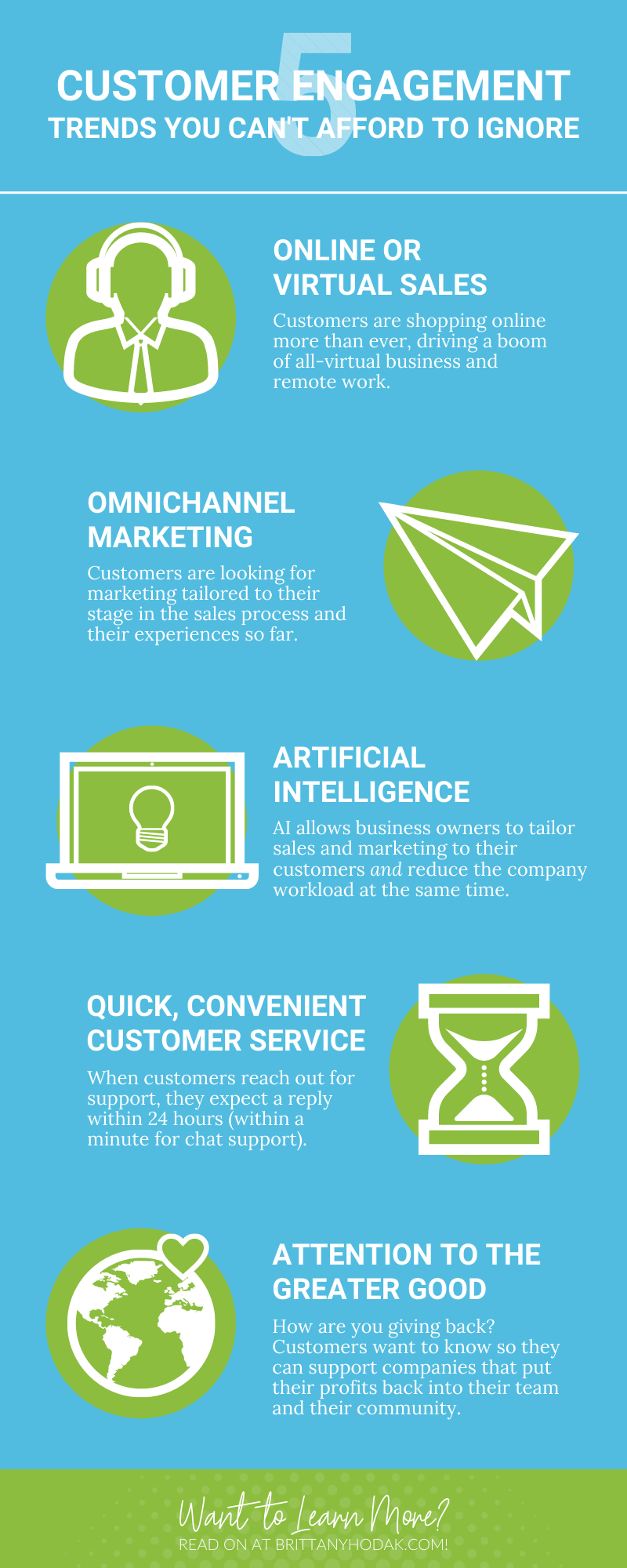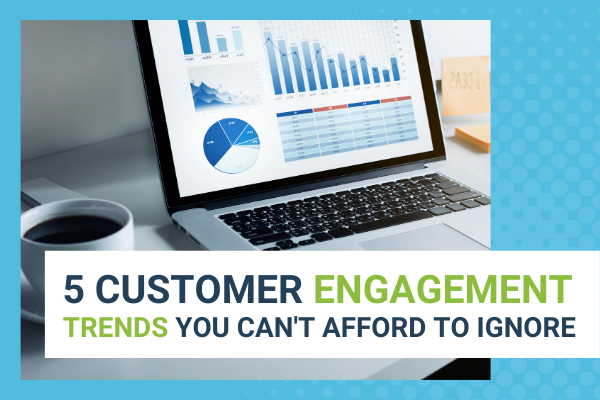Every interaction with a customer is a form of customer engagement. In recent years, this has become quite the buzzword, but is it really all it’s cracked up to be? Customer engagement is more important than you think, but too few brands actually understand what it is and why it’s important.
Though the term can be confusing to define, it’s essentially any and all interactions with customers. The way brands handle customer engagement is changing, as are customer expectations. It’s essential that you not only adapt to these changes but that you anticipate them.
Like customer experience, customer engagement can’t be ignored. When you have engaged customers, you have profitable customers. In fact, customers who are fully engaged represent a 23% higher share in profitability and relationship growth. No matter your industry, you need to know how to engage your customers, make them happy, and create more superfans.
With that in mind, how do you engage your customers in today’s world? In this guide, we’ll explore 5 customer engagement trends you can’t afford to ignore. No matter what stage you are in your customer-first strategy, customer engagement can’t be an afterthought. By the end of this article, you’ll understand why. More importantly, you’ll become an engagement advocate yourself.
What is customer engagement?
First and foremost, what even is customer engagement? The definition behind this term can be hard to come by, especially with so many so-called experts throwing the term around like a buzzword. In simple terms, customer engagement is the interactions between customers and your brand.
This isn’t just sales and support interactions either. Engagement is the ongoing process of brands anticipating customers’ needs and connecting with users. From educational content to social media copy, these efforts encourage two-way conversations throughout the sales funnel.
The goal of customer engagement is to achieve top-of-mind awareness with customers. When you continue to interact with your audience, you build actionable brand awareness. The next time your customer thinks about your industry, they think about your brand. This is what it means to build a business based on superfans.
Why is customer engagement important?
With the definition in mind, why is customer engagement an important part of modern business? There are a lot of benefits to customer engagement, and it’s no longer optional if you want to stay relevant. Here’s why your engagement matters:
- Relationships: Users increasingly want to build relationships with the brands they support. This is especially true for businesses that operate online. Engagement is a way to build these relationships organically.
- Loyalty: When you focus on value-based customer engagement, you build real, trusted brand loyalty. These superfans are willing to not only pay more, but they also love to share their experiences.
- Branding: Nowadays, your brand identity carries a lot of weight. Your interactions are a way to brand yourself and establish your identity apart from the competition.
- Customer service: Providing outstanding customer service can’t be an afterthought. When you offer great service and interactions, you create brand evangelists.
- Reduce churn: Most importantly, customer engagement reduces churn. By continuing to engage with customers throughout their journey, you encourage repeat purchases and cross-selling opportunities.
These are just a few of the most important ways customer engagement boosts your business. With a reported 86% of buyers willing to pay more for a better customer experience, customer engagement is an investment in the future of your company.
5 Customer Engagement Trends You Can’t Afford To Ignore
Now that you understand what customer engagement is, how can you leverage it for your brand? The best way to get started is to keep an eye on the trends. These affect your customers’ expectations, and they’re a part of being proactive (not reactive).
Let’s take a closer look at the 5 customer engagement trends you can expect to see in the upcoming year. These are becoming the new normal, so the time to adapt is right now.
Online Or Virtual Sales
Firstly, it should come as no surprise that we live in a digital world. The days of digital transformation are here to stay. If you have a business in any capacity, you need to have a digital-first strategy for online or virtual sales.
Whether this means selling products online, using apps like Instacart or DoorDash for immediate delivery, or hosting virtual meetings online, you need to adapt. This is the new normal. As of 2021, 89% of companies have already adopted a digital-first business strategy or plan to do so. No industry is exempt from these changes, from restaurants to retail to B2B sales.
For example, when doctor’s offices use a digital tool like Zocdoc to allow patients to book an appointment online, they actually save money. First, research suggests patients are less likely to cancel or fail to show up to appointments that are made digitally. Second, they are able to fill appointments that are canceled at the last minute. As you can see, going virtual pays off.
Omnichannel Marketing
Next, omnichannel marketing is when you create an integrated shopping experience for customers. By blending ways to reach customers, it becomes a seamless shopping experience. For example, you might send a customer an SMS message about a sale when they shop in-store, or you send a cart abandonment email after they fail to make a purchase online.
There are so many different ways customers interact with your brand nowadays. These should all be a seamless part of the sales and marketing experience. One real-world example of a brand that understands the power of omnichannel marketing is UNIQLO. This Japanese-based retailer opened retailers across North America, and they use their app to serve customers in-store and online.
When customers use their app to pay in-store, they get access to app-online discounts, e-receipts, and special perks. This encourages customers to keep interacting with the app even when they’re not shopping in-store. Ultimately, it’s a better experience all around.
Artificial Intelligence In Sales And Marketing
Additionally, another trend that can’t be ignored is artificial intelligence (AI) in sales and marketing efforts. Today’s marketers have access to endless tools and resources to deliver personalized, engaging content to customers based on real-time data. By 2025, up to 95% of customer interactions are expected to be AI-powered.
The coffee brand Starbucks truly excels at this. Like UNIQLO, they also use their app to serve customers. However, they aren’t afraid to rely on AI to deliver timely sales and marketing efforts. Through their app, customers update their real-time location and data to find local deals and stores.
Moreover, by using customer insights learned through the app, their AI suggests relevant drinks and repeat purchases. Essentially, they leverage what they learn more about users to boost sales and connections. Known as Deep Brew, Starbucks’ AI tech is a key part of how the company plans to grow in the future.
Quick And Convenient Service
Additionally, you can’t afford to ignore the value of fast, convenient service. Customers not only want to choose how they’ll receive service, but they also expect service quickly. In the US, over 60% of customers prefer digital self-service tools. This means having website content, mobile tools, voice response systems, and online chat all available to offer quick self-serve.
Amongst self-serve tools, customers prefer knowledge bases. This means it’s worthwhile to invest time in helpful guides, videos, and FAQs so customers don’t need to reach out to your team in the first place. Lastly, don’t forget that 88% of customers expect a response from your brand within 60 minutes.
Imperfect Foods is a food delivery service that takes advantage of comprehensive self-serve tools. Their FAQ includes clear solutions to the most common questions, and they walk customers through different processes themselves. This not only empowers the customer to learn more about their service, but it saves their support team from answering the same questions repeatedly.
Attention To The Greater Good
Finally, one of the biggest customer engagement trends you can’t afford to ignore is giving back. Today’s customers want to support companies that are doing good. While you can choose to do good and give back any way that makes sense for your brand, one popular choice is sustainability.
When you do good with your brand, customers feel good supporting you. If it’s between you and the competition, they’re going to choose the brand that’s making the community a better place. Whether you engage with your community, donate to important causes, or reduce your carbon footprint, make an impact.
The global soda brand Coca-Cola launched Mission 2025 to show customers how they’re paying attention to the greater good. They’re focusing on 6 key areas: reducing emissions, water use, waste-free packaging, ingredient sourcing, nutrition, and communities. Coca-Cola currently has the highest environmental sustainability investment rating. This is something customers notice and appreciate.
Conclusion
Ultimately, the world is changing quickly. You can either choose to ignore these customer engagement trends and get lost in the crowd, or you can take a proactive approach. These 5 trends above easily fit into any existing customer-first strategy. Now is the time to take real action.
By focusing on customer engagement, you enhance your overall customer relationships. These relationships should always be based on trust, authenticity, and real-world change. After all, your customers aren’t just transactions on a sales page. They’re the foundation of your business.

